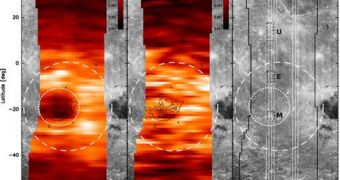A new scientific investigation has demonstrated the existence of a previously-unseen type of solar wind interaction, that occurs only around celestial bodies in our solar system that feature no air in their atmospheres.
The interaction was clearly observed in the case of Earth's natural satellite. It takes place mostly on the far side of the Moon, around magnetized areas called magnetic anomalies, AlphaGalileo reports.
These regions were found to play a critical role in protecting the lunar surface from the influence of harmful radiation, by successfully and efficiently deflecting solar radiation.
Such a discovery bears important implications, because it could help explain why water develops in the upper layers of the moon's surface. The work could also yield additional details as to how the body interacts with the Sun.
The results of the new investigation will be presented in Rome, Italy today, September 24, by professors Drs. Yoshifumi Futaana and Martin Wieser. They will be speaking to colleagues gathered at the European Planetary Science Congress.
Planetary scientists explain that Earth is shielded from solar winds by its magnetosphere. This is a layer of the atmosphere that is powered by our planet's moving core.
But most planets and moons in our solar system are tectonically dead, meaning that their cores have stopped spinning millions of years ago. They also feature no air, or no atmospheres altogether.
Without a protective shield, the surface of these celestial bodies, including Mars, Venus, the Moon and Mercury, is heavily battered, by both solar winds, radiation, and space rocks.
In the case of Earth's natural satellite, the interaction causes the formation of a very rough type of soil, called regolith, samples of which were brought back by Apollo astronatus.
“These results may change dramatically the way we understood the solar wind-regolith interaction so far,” explains Dr. Futaana, who is based at the Swedish Institute of Space Physics.
“Since the solar wind is one potential source of water on the Moon, we need to make better models of the lunar hydrogen circulation in order to understand how water molecules form in its upper layers,” the expert says.
“Also, it will be possible to remotely investigate the solar wind-surface interaction on other airless bodies, such as the Martian moon Phobos or Mercury, by imaging the energetic hydrogen atoms that are reflected back to space when solar wind hits their surface,” he concludes.

 14 DAY TRIAL //
14 DAY TRIAL //